I was 12 or 13 when I came out of school. I was the third fella in the family – I got the job, the rest of them went to school. I was only a garsún when I was above labouring on farms.
I was getting 10 shillings a week then at that time. I’d get two shillings for myself and the rest would go to the house. You had to give the money to your mother. There was no smoking or drinking, I didn’t drink until I was 22 years of age. I had a Babycham at my sister’s wedding and I nearly fell down on my arse.
I was working away and I got a woeful interest in the timber. I used to be cutting old ash plants that you’d have for working and things. Fellas would ask me then: “Any ash plants?” Sure I used to have to darken their ash plants and I said there was a couple of pound in it. That time you’d only get two shillings and six pence.
That’s really how I got into making the sticks, but I was always interested in nature.
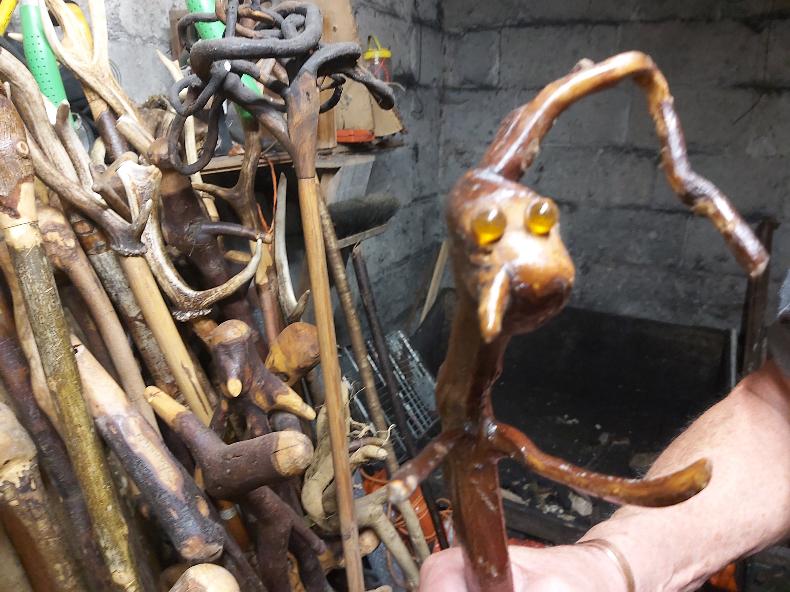
Some of Seánie Barron's creations.
We lived near a big wood in Askeaton growing up. We used to go over to it in the summer time. There were stepping stones on the river and I used to hop from one stone to the other. The boys used to cycle down and around, but I was faster running.
Sticky situation
No one trained me whatsoever – I wanted to be a carpenter one time. I hadn’t much time for making walking sticks, but the ash plant was always a good old thing. When I got a bit of time to myself, I was making the walking sticks. I was interested in the blackthorn walking sticks and the hazel walking sticks.
When you were out hunting, you could use the stick to keep down the electric fences. If you were hunting along the river, your trousers were wet and you hit the electric fence, it’d burn the trousers off you. So we used to come on then with a prong at the end of the stick, and you’d shove it down to keep down the fence.
Now I have a ‘tickler’ I call it, because if the fence hits you, it’ll give you a tickle. It’s a small bit of timber that goes into the shank of the stick, slanting down. You don’t have to turn the stick upside-down anymore.
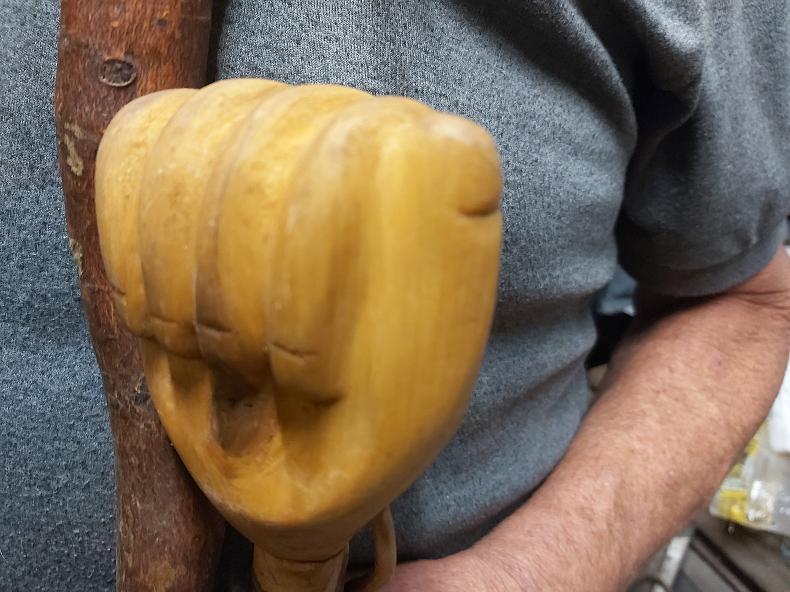
When you’re running, you can just shove that on the fence. It’ll keep it far enough down that you can go over, but I bring my terrier hunting with me, so it’s high enough that the terrier can go under it and stay with me. I’ve it kind of patented.
After a while, you get an awful eye for sticks. For me, the roots will tell you everything, you could see anything in the roots. The root is the handle.
I’ve the funniest sticks you ever saw. One with a horse’s head and a jockey above on the back of it, all in the one kind of root. I’ve another, it looks like the hunchback of Notre Dame. I put whistles in some of them too.
January or February is the best time to pick a stick. No sap in them or anything like that. But the best time to pick a stick really, is when you see it. When I was doing a lot of work up and down the country, you’d see a lovely stick, you’d cut it and bring it with you.
You leave it outside then for about six months, let it dry. The sap would be gone out of it. You’ve a lovely stick then, clean it up and varnish it.
It’s very interesting work – it’s great for the body, the soul and the mind
Blackthorn sticks are beautiful, but any stick is nice, even a shrub. They’re red and some of them are green – they make beautiful walking sticks. A lot of people go for colour. You don’t have to paint them at all, just varnish over them. You always have to put a nice little handle on them. I got tools lately, you can tap away and carve lovely things in them.
I make a few different things, signs and a few bits now. I used to sell the sticks at fairs and the marts. It’s very interesting work – it’s great for the body, the soul and the mind.
Exhibition
I’ve had a good few exhibitions – I was above in Trinity College before. One fella says to me: “Where are you going?” I says: “I’m supposed to be going up to Trinity College, wherever it is.” I didn’t know where it was at all. 
You’d have to talk then for about an hour or two at the exhibition, fellas asking you questions. I was delighted with the thing, talking away good-O.
They came from Wexford and Donegal. Jesus, there was about 200 people there, but you wouldn’t see them when you were talking. Then all of a sudden, the lights would come on, and you’d see all these people looking at you. You’d nearly get a small bit of a fright then.
People say it’s art.
I always see things – my mother was an awful woman for seeing things. We could pass a field and she’d say: “Look at that field up there, that field is like a harp.” If you study the clouds, you see faces in them, volcanoes and all different things.
If you put it in your brain, you can put it in your hands, then you can put it on to the stick and make it.
As long as I live, I’ll be making a stick.
Read more
‘I was above in the shed bedding bullocks and much happier doing it’
My Country Living: ‘Without volunteers we’d be nothing’
I was 12 or 13 when I came out of school. I was the third fella in the family – I got the job, the rest of them went to school. I was only a garsún when I was above labouring on farms.
I was getting 10 shillings a week then at that time. I’d get two shillings for myself and the rest would go to the house. You had to give the money to your mother. There was no smoking or drinking, I didn’t drink until I was 22 years of age. I had a Babycham at my sister’s wedding and I nearly fell down on my arse.
I was working away and I got a woeful interest in the timber. I used to be cutting old ash plants that you’d have for working and things. Fellas would ask me then: “Any ash plants?” Sure I used to have to darken their ash plants and I said there was a couple of pound in it. That time you’d only get two shillings and six pence.
That’s really how I got into making the sticks, but I was always interested in nature.

Some of Seánie Barron's creations.
We lived near a big wood in Askeaton growing up. We used to go over to it in the summer time. There were stepping stones on the river and I used to hop from one stone to the other. The boys used to cycle down and around, but I was faster running.
Sticky situation
No one trained me whatsoever – I wanted to be a carpenter one time. I hadn’t much time for making walking sticks, but the ash plant was always a good old thing. When I got a bit of time to myself, I was making the walking sticks. I was interested in the blackthorn walking sticks and the hazel walking sticks.
When you were out hunting, you could use the stick to keep down the electric fences. If you were hunting along the river, your trousers were wet and you hit the electric fence, it’d burn the trousers off you. So we used to come on then with a prong at the end of the stick, and you’d shove it down to keep down the fence.
Now I have a ‘tickler’ I call it, because if the fence hits you, it’ll give you a tickle. It’s a small bit of timber that goes into the shank of the stick, slanting down. You don’t have to turn the stick upside-down anymore.

When you’re running, you can just shove that on the fence. It’ll keep it far enough down that you can go over, but I bring my terrier hunting with me, so it’s high enough that the terrier can go under it and stay with me. I’ve it kind of patented.
After a while, you get an awful eye for sticks. For me, the roots will tell you everything, you could see anything in the roots. The root is the handle.
I’ve the funniest sticks you ever saw. One with a horse’s head and a jockey above on the back of it, all in the one kind of root. I’ve another, it looks like the hunchback of Notre Dame. I put whistles in some of them too.
January or February is the best time to pick a stick. No sap in them or anything like that. But the best time to pick a stick really, is when you see it. When I was doing a lot of work up and down the country, you’d see a lovely stick, you’d cut it and bring it with you.
You leave it outside then for about six months, let it dry. The sap would be gone out of it. You’ve a lovely stick then, clean it up and varnish it.
It’s very interesting work – it’s great for the body, the soul and the mind
Blackthorn sticks are beautiful, but any stick is nice, even a shrub. They’re red and some of them are green – they make beautiful walking sticks. A lot of people go for colour. You don’t have to paint them at all, just varnish over them. You always have to put a nice little handle on them. I got tools lately, you can tap away and carve lovely things in them.
I make a few different things, signs and a few bits now. I used to sell the sticks at fairs and the marts. It’s very interesting work – it’s great for the body, the soul and the mind.
Exhibition
I’ve had a good few exhibitions – I was above in Trinity College before. One fella says to me: “Where are you going?” I says: “I’m supposed to be going up to Trinity College, wherever it is.” I didn’t know where it was at all. 
You’d have to talk then for about an hour or two at the exhibition, fellas asking you questions. I was delighted with the thing, talking away good-O.
They came from Wexford and Donegal. Jesus, there was about 200 people there, but you wouldn’t see them when you were talking. Then all of a sudden, the lights would come on, and you’d see all these people looking at you. You’d nearly get a small bit of a fright then.
People say it’s art.
I always see things – my mother was an awful woman for seeing things. We could pass a field and she’d say: “Look at that field up there, that field is like a harp.” If you study the clouds, you see faces in them, volcanoes and all different things.
If you put it in your brain, you can put it in your hands, then you can put it on to the stick and make it.
As long as I live, I’ll be making a stick.
Read more
‘I was above in the shed bedding bullocks and much happier doing it’
My Country Living: ‘Without volunteers we’d be nothing’







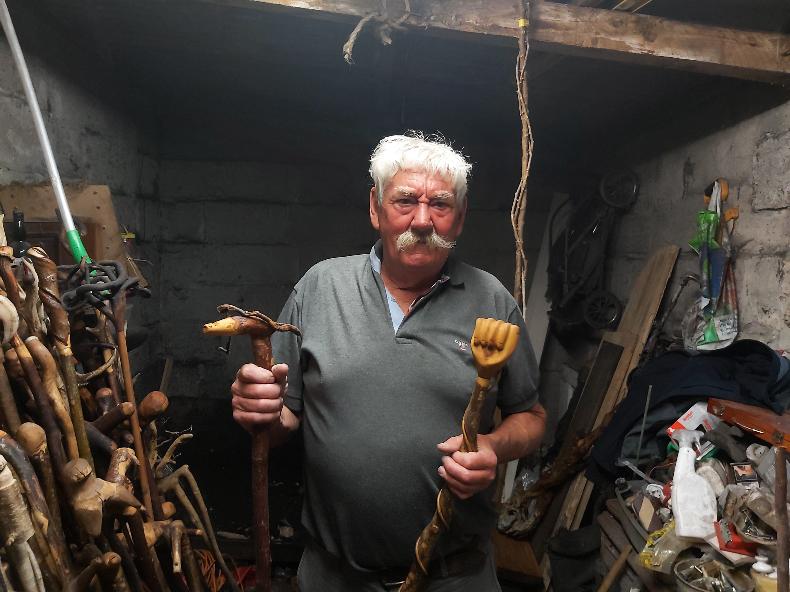
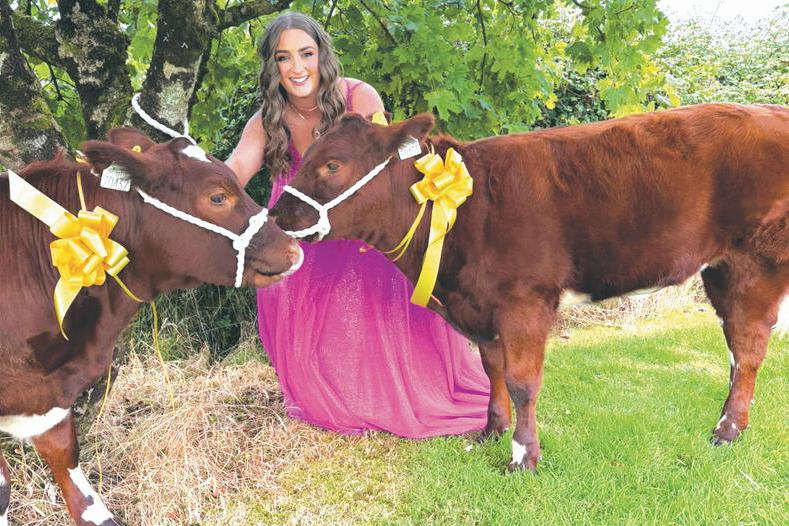
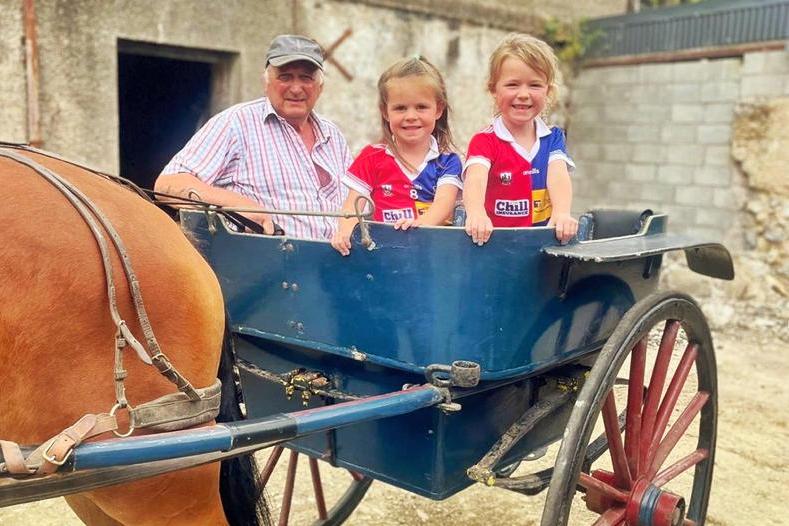
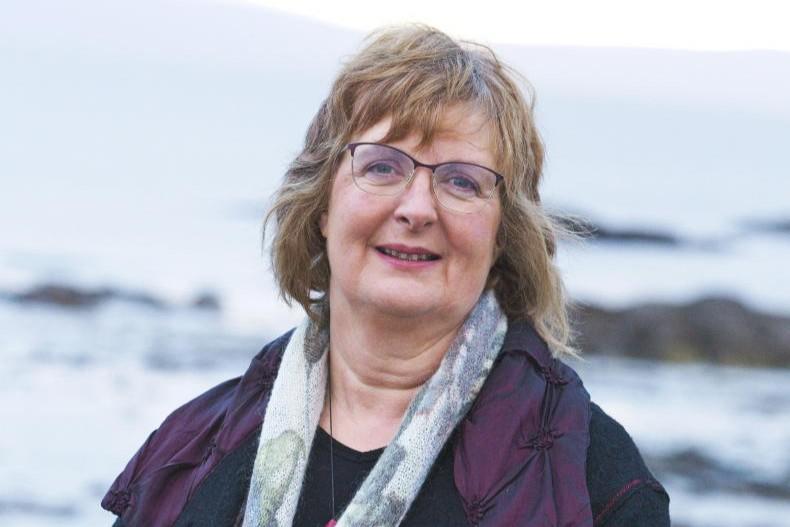
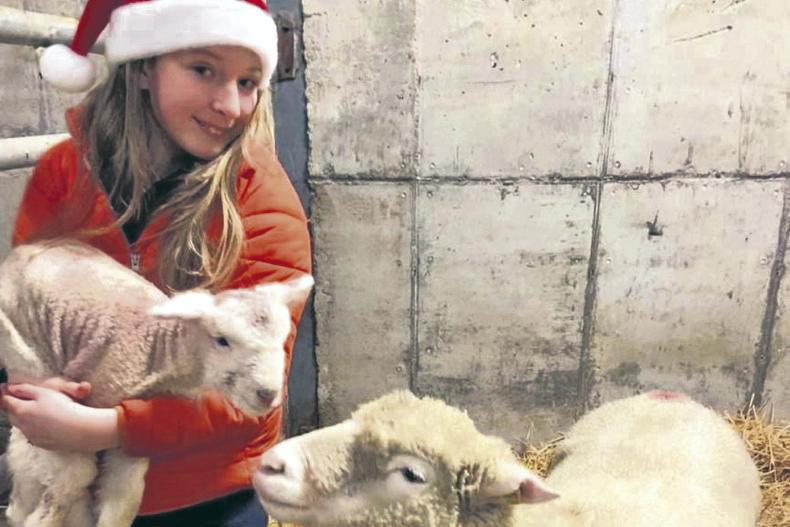
SHARING OPTIONS